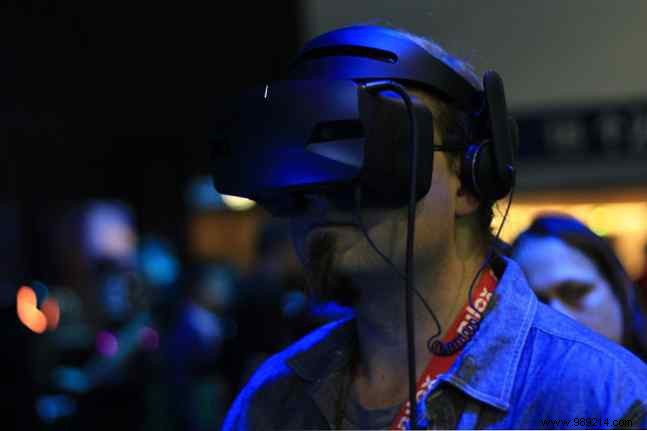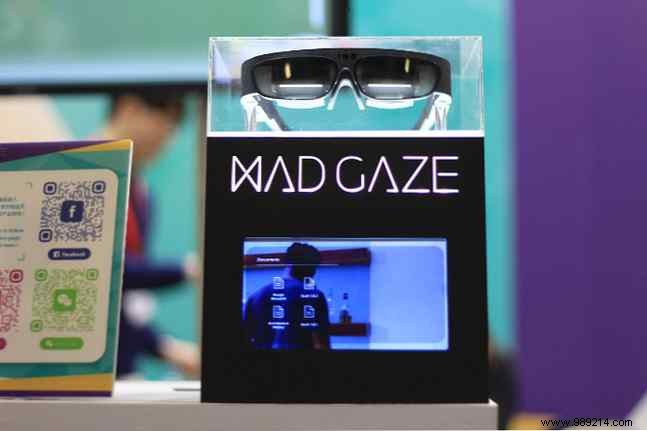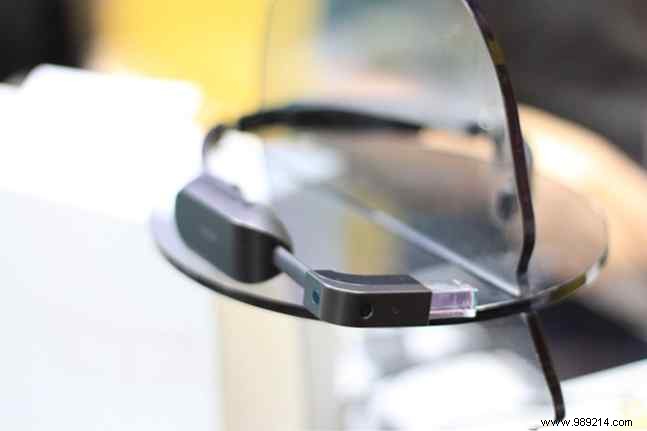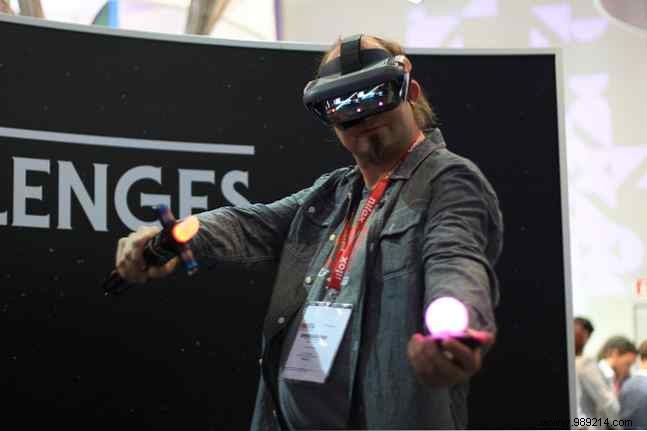The consumer VR space is halfway through product cycles, so our expectations for IFA this year were low. But still, we expected a bit more than we found.
Oculus was notably absent from the series, as was HTC, which is a shame, as its Wi-Gig-based wireless adapter for the Vive is up for pre-order on September 5. I was hoping that at least that would be a demo along with the Vive Pro, but I guess they couldn't afford to attend the show.
Instead, we saw plenty of mobile VR cases, which we won't bore you with, except for one innovative Star Wars item that turned your mobile phone into an augmented reality headset (scroll down for more). /P>
So here is the extensive List of what was shown at IFA 2018 in the Virtual Reality and Augmented Reality sectors..
The EYE 500 (pronounced with a soft J, like “Oh ho”), updates Acer's mixed reality offering, with a resolution of 1440 x 1440 px per eye. That's still higher than the original Vive and Oculus Rift, but the same as other WMR headsets. It comes at a price of $400/€500, which doesn't include optional Bluetooth controllers. It also features a stiff head strap with built-in headphones, which felt comfortable and sounded reasonably good during our tests. The hideous blue front panel has also been upgraded to a more demure black/gray.
Don't let the names fool you, though:this is still just VR, with no pass-through camera capabilities. "Mixed Reality" is simply the brand name that Microsoft applies to all headsets in its ecosystem, regardless of their capabilities. Like the Dell Visor Dell Visor Mixed Reality Headset Review [Updated] Dell Visor Mixed Reality Headset Review [Updated] Tracking tech is promising, but wait until we see SteamVR support. Right now, the Oculus Rift represents much better value for money. Read More

Uniquely, the Acer OJO 500 has a detachable lens and screen unit, allowing for easy cleaning and storage.
During our short time with the device, we only got a chance to play the Microsoft Halo shooting gallery demo, which is just as bad as VR. Still, the resolution bump was noticeable. However, state of the art drivers were being demoed with it, so no improvements there. If they have designed new controllers to go along with them, they keep quiet about it.
MadGaze hopes to ride the current wave of AR excitement with a couple of products, and is now launching a wider release after successful Kickstarter campaigns:the Vader and X5. Both are based on Android, which allows the user to run any generic APK or make specific applications that use the MadGaze software SDK. Both devices feature cameras, capable of displaying an augmented view of the real world when pre-programmed bookmarks are displayed.

The Vader model is a full AR headset for overlaying 3D content on both eyes, and is the higher spec of the two devices, running Android 7.0 on a 1.5GHz CPU. Interestingly, instead of trying to add to the user's vision, they use a pair of cameras to broadcast the real world view with the augmented content, on a pair of 720p screens. The result felt a bit sluggish, but the field of view was reasonable. They demonstrated the unit with a custom game, with user interactions performed by picking up and touching the right side of the headset. Unfortunately, they weren't meant to be worn over existing glasses, so everything was a bit blurry for my nearsighted eyes. They also felt quite heavy and would have benefited from a headband to keep them on. The Vader is retailing soon for around $700, still less than a third of the price of a Magic Leap:One.

The MadGaze X5 is essentially a Google Glass clone for an affordable price of $500. Running Android 6.0 on a 1.3GHz CPU. It features a small glass mirror to display a WVGA (800 x 480p) screen in the corner of a single eye. Fits over your existing glasses, or has a simple headband. The display was surprisingly good, easily visible in the full glare of the exhibition lighting. I could see myself augmenting daily life with a continuous stream of inane YouTube videos, or scrolling through emails, though that would presumably be with some custom software.
The Jedi Challenges playset consists of a mobile VR shell (wait, read on, it's not just Google Cardboard), a tracking beacon, and a lightsaber. With your mobile phone slid on top of the device, the screen is mirrored to increase the view of the real world, offering a reasonable field of view, although not as immersive as virtual reality.

The cameras built into the headset provide positional tracking (but don't expect Vive-level room scaling; think more PSVR-level), as well as tracking the position of your lightsaber. Three games are included, though we only tried Yoda's battle, which involved pairing up your lightsaber to set up positions, then whacking Yoda around a bit. A future update has been promised that enabled matchmade play, which of course will require two games of play.
Lenovo Star Wars:Jedi Challenges smartphone-powered augmented reality experience Lenovo Star Wars:Jedi Challenges smartphone-powered augmented reality experience Buy Now On Amazon $125.00
The Lenovo Jedi Challenges game is available now for around $170 to $200. Should you buy it? Probably not. For about the same price, you can buy an Oculus Go Oculus Go:the best mobile VR that doesn't even need a phone. Oculus Go:The best mobile VR that doesn't even need a phone. The software will disappoint experienced VR gamers. Selection and lack of positional tracking, but for watching video the Oculus Go is amazing. With a higher resolution than PC VR headsets, and great convenience... Read More instead, which runs independently and allows access to a much larger software library than just three Star Wars games .
Winning no awards for innovative product names, VR2 is Huawei's second generation of VR headsets, with the highest resolution we've ever seen up to 1600 x 1440pp per eye. It is purely an output device, with no internal system, so it cannot run independently. With a Displayport input, it can be connected to a Huawei phone (or anything else that produces Displayport, although we only tested with the P20 Pro), or a PC running SteamVR.
Unfortunately, there is no positional tracking and the controller is a simple pointer, so the variety of games you can play is very limited. In order to demonstrate the capabilities of SteamVR at room scale, they were connected to a third-party NoloVR motion controllers and tracking system, which was absolutely horrible and costly to make us sick. Without a decent integrated tracking system or the combination of the Valve Lighthouse system, we can't see a market for this. Apparently Huawei can't do it either, because the VR2 is still a Chinese-only version, is it available for 2000? (about and $300).
Of course, VR isn't dead, which is why I've refrained from using such a silly phrase as a clickbait headline. VR has barely started yet. What we do know is that few manufacturers feel their VR ecosystems are ready for broader consumer markets and are hard at work on second-generation headsets. However, Mixed Reality headsets don't stand a chance if they continue to be demonstrated with a gallery of Halo 2D shots. VR is a tough sell anyway, but even more so when placed next to the trade show, it's easier to sell shiny new laptops.
If we find more VR or AR technology at IFA 2018, we will update this post. Even if you don't hold your breath.